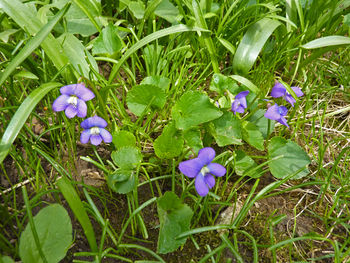Blue Violet
From Wikiwel
Other Names : Viola sororia, Common Blue Violet
Contents
Special Precautions of Blue Violet
- The seeds and roots should be avoided because they can cause allergic reactions, vomiting, diarrhea and dehydration.
Actions
Alterative, laxative, nutritive and demulcent.
Health Benefits and Uses of Blue Violet
The flowers and leaves are both edible and rich in vitamin’s A and C. The accounts of their uses abound for all the violets. As far back as 1885, a study compared violet leaf vitamin C content to that of oranges and vitamin A content to that of spinach. From the basal leaves, if collected in spring, this early research reported that violets contain twice as much vitamin C as the same weight of orange and more than twice the amount of vitamin A, gram for gram, when compared with spinach! (Erichsen-Brown, 1979).
- An excellent lymphatic herb, Violet is used for chronic lymphatic swelling and stagnant lymph especially associated with constipation.
- It has been used by the native indian Cherokee for dysentery, blood, colds, coughs (when sugar added), headaches and as a spring tonic. Early European recipes made syrup of the blossoms and traditionally it was used as a laxative for infants and children (Grieve, 1996). Sweet violet, also, has a long history of use as a cough remedy, especially bronchitis, and functions as an expectorant, as well as an anti-inflammatory (Hoffman, 2003). An infusion of the plant to treat dysentary, caughs, and colds.
- Poultice of leaves to allay headache pain
- An infusion can also be sprayed up the nose for catarrh or buildup of mucus in the nose or throat.
- A poultice of the crushed roots was applied to boils.
- The Flowers can be turned into a candy by dipping the flower into water, cleaning it off and drying it. Then lightly brush beaten egg whites onto the flower, cover with sugar and dry.
- The leaves are rich in Vitamin A and C and can be added to salads, boiled for 5-10 minutes and eaten as cooked greens are added to soups as a thickener. Dried leaves can be made into a tea.
- An infusion of the root was used to soak corn before planting to keep insects off as an insecticide. (Cherokee)
- Cancer : Many of the older European-based herbalists, such as Grieve, who first published A Modern Herbal in 1931, and De Bairacli Levy (1973), note that violet has been used, historically, for the treatment of cancer. In America, there are accounts of Native Americans utilizing violet for cancer treatment (Erichsen-Brown, 1979). To my surprise, the American National Cancer Institute has been made aware of the folk uses of violets for cancer since at least the 1950s. (Erichson-Brown, 1979). Have we studied this herb for further evidence of violet’s potential effects on cancer? Yes! One recent study concluded that an aqueous Viola extract (i.e. tincture) inhibited the proliferation of activated lymphocytes (Hellinger, 2014) as well as negatively affecting other hyper-responsive immune functions. This indicates that violets may be useful in the therapy of disorders related to an overactive immune system (Hellinger, 2014).
